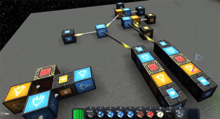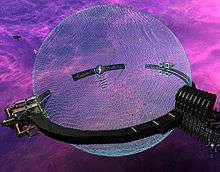StarMade
| StarMade | |
|---|---|
 Official StarMade logo | |
| Developer(s) | Schine |
| Publisher(s) | Schine |
| Designer(s) | Robin Promesberger |
| Platform(s) | Windows, Macintosh, Linux |
| Release date(s) | February 28, 2012 (Alpha) |
| Genre(s) | Open world, Sandbox, Space flight simulator game, First Person Shooter, Sci-Fi |
| Mode(s) | Singleplayer, multiplayer |
StarMade is an infinite open-universe space simulation sandbox game in development by Schine for Windows, Macintosh and Linux. StarMade is currently in alpha and is free to play, during alpha.[1]
Gameplay

In StarMade, the player (Astronaut) explores an endlessly generated voxel world, in a player created spacecraft. This world contains randomly generated asteroids, shops, spaceships and planets. Each planet is randomly generated with a planet biome. There are several planet types which include Terran (grassy), Ice, Desert, Alien and Red Planets. Players can customise their ships with thrusters, to increase flying speed around the universe.[2][3]
Players can create multiple ships with a "Ship Core" block. They can then proceed to customize their ship in the game's "Ship Build Mode", or add materials in the default player mode, outside of the ship. Ships can be customized with a variety of materials to enhance performance, add new features or create combat/defense systems. The universe is populated with other astronauts and ships such as Pirates, which can be killed to salvage materials from their destroyed ships. Pirates are hostile entities which will usually attack on sight if ships are equipped with a weapon system, salvage ships are less likely to provoke Pirates. There are a variety of weapon systems, such as missiles, beams and lasers which all require a different weapon CPU type which will be determined on the model.
Crafting is present in the game, and is known as "Manufacturing". Players can craft parts with blocks called "Factories". Each factory has its own inventory and specific list of items that only those blocks can manufacture. Factories require power in order to manufacture other parts. Once a factory has been powered, players can put the ingredients in the right factory block, and it will start producing whatever it is programmed to produce with an interval of roughly 5 seconds. Players can collect materials to craft all over the universe.
Sandbox

Sandbox on StarMade is the primary playing mode, used for singleplayer mode. Players must gather natural resources (such as ore, stone, etc.) or salvage ships and shipyards found throughout the universe in order to craft certain parts and items using the manufacturing feature. The mode also features a health bar which is depleted by attacks from pirates, astronauts and eventually being exposed to space outside a ship for too long. Players also have a Power Bar, which is used to display the power of the ship being piloted. Power is necessary for any technology and can be generated from power generators.
There are a wide variety of items and parts that players can manufacture in StarMade. Players start manufacturing by crafting a Basic Factory from their inventory. The Basic Factory Block acts as the beginner crafting table. In order to craft items, players place the ingredients in the inventory of the factory and they select a recipe to start crafting from. Then the Factory block will produce items every tick until it runs out of ingredients. The Factory Block can be used to manufacture more advanced crafting blocks as well. Each Factory can craft things that the other tiers cannont. For example, The Standard factory can craft items that the Basic Factory and Advanced Factory cannot craft. Players may also buy parts and ingredients in the randomly spawned shops with the credits currency.
The game has an inventory system and players are limited to the different number of items they can carry. Upon dying, the player will lose a portion of their credits as long as spawn protection isn't active, and players respawn at their current spawn point, the home shop which is set by default when players begin the game in sector 2,2,2, but can be reset if a player sets their spawn point with a Plex Undeathinator.
Multiplayer

Multiplayer in StarMade is available through player-hosted servers and lets multiple players to interact and communicate with each other in a single universe. Players can also run their own servers on a personal computer. StarMade multiplayer servers are guided by server admins, who have access to server commands, such as spawning items, or warping to players and ships. Admins can also set up restrictions concerning which usernames or IP addresses - using a whitelist - are allowed to enter the server. Multiplayer servers offer players a wide range of activities, such as role-playing, building ships with others, and building bases. Some servers even have their own unique rules and custom blocks.[4]
Development
Robin Promesberger announced he had begun development of StarMade around 2010, describing it as a "Minecraft inspired 3D sandbox space shooter." The game was primarily inspired by the feel of Minecraft and various space themed TV shows. Promesberger had been developing the engine behind StarMade for almost a decade. In mid 2012, Kevin "Beetlebear" Collins joined StarMade and helped redesign the textures of the game, until he later decided to leave development on September 15, 2013, due to a disagreement in his share of the game's revenue with Promesberger. On November 2, 2013, it was announced that Keaton Pursell would be working on 3D Models for the game.
On July 24, 2013, StarMade was greenlit by the Steam community, meaning the game would eventually be added to the Steam store. It was officially made available on Steam on December 4, 2014.[5]
See also
- Lightweight Java Game Library, a Java library used by StarMade.
References
- ↑ "StarMade combines elements of Minecraft, EVE and Elite for voxel-based space adventure". PC Gamer.
- ↑ "StarMade Is Like Minecraft In Space And It's On Steam Greenlight". cinemablend.com.
- ↑ "StarMade Is, Essentially, Minecraft In Space". Siliconera.
- ↑ "Space Oddities: The RPS StarMade Server - Rock, Paper, Shotgun". rockpapershotgun.com.
- ↑ "Steam Greenlight :: StarMade". steamcommunity.com.